December 05, 2014
Oh, This Is Gonna Be Good.
I've just gotten started on First Episode Writeup #2, and I've got that feeling I had during Rio Rainbow Gate!... nothing is being forced, it's all just coming out like it was meant to be, and even better, I'm enjoying it! While you wait, however, here's pictures.

Quite a lovely photograph, no? I have it as one of my rotating lock screens as an example of what people like to think of winter looking like.

As opposed to what it really looks like. Closest thing to a good picture that I've taken with my cellphone. It hasn't rained much this winter so far, nor has it really snowed. We had one threat of up to five inches of the white stuff, but all we got was a dusting.
I'm pretty much okay with that, truth be told.

Quite a lovely photograph, no? I have it as one of my rotating lock screens as an example of what people like to think of winter looking like.

As opposed to what it really looks like. Closest thing to a good picture that I've taken with my cellphone. It hasn't rained much this winter so far, nor has it really snowed. We had one threat of up to five inches of the white stuff, but all we got was a dusting.
I'm pretty much okay with that, truth be told.
Posted by: Wonderduck at
03:11 AM
| No Comments
| Add Comment
Post contains 143 words, total size 1 kb.
December 03, 2014
First Episode Writeup #1
While we're waiting for the Kantai Collection anime to finally come down the pike, I'm going to try something different for a while. Since there's only a month or so until the Winter season begins, I probably don't have enough time to do a writeup for an entire series worth of episodes... but I can do single episodes with no problem! Take the first episode of a show, inflict upon it my own special kind of love and kindness, leave it broken and bleeding in the dirt, and move on, laughing at my own callousness. Unless, of course, there's an outpouring of feeling demanding I do the rest of the series, in which case I'll consider it. Then leave it, too, broken and bleeding in the dirt whilst I do the evil laugh and twirl my mustache like Snidley Whiplash (kids, ask your parents). I dunno how it'll work, but I think it has the potential of being kinda fun! Heck, why not, let's give it the ol' college try.
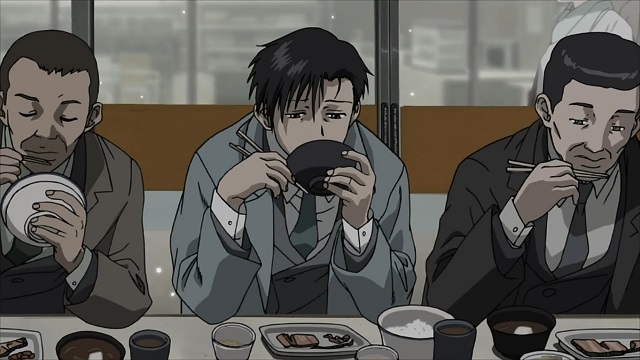
Say hello to Skippy. That's probably not his name, but as we've yet to be told what it is, Skippy will do for now. Skippy is pretty much your average to slightly-below-average salaryman cliche. He works long hours for a huge multinational corporation in an unrewarding job, has no time for a life outside of work, and tends to wear a lot of gray.
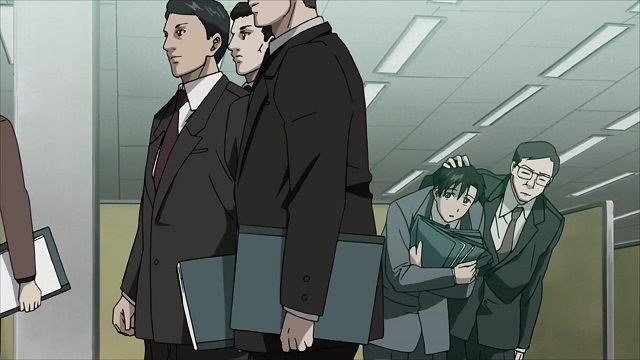
His direct superior treats him like whale snot on the bottom of your shoe, and why not? That's how his boss treated him when he was just starting out in the company, and if it was good enough for him, it's good enough for Skippy, only doubly-so. After all, now HE'S the boss and he's got to make sure the underlings know it. Skippy meekly bends over and takes it, because that's how it's done in Stereotypical Salaryman's Life, and hopes to someday move up in the world, into a position where he might be able to make someone else as miserable as he is today.

His appears to be a crapsack world indeed. Nowhere in it is there room for things like zombies, bento fights, technomagical girls with kickarse scarves or happy gambling paradises. All is gray, and that's the way it's always been, and that's the way it'll always be.
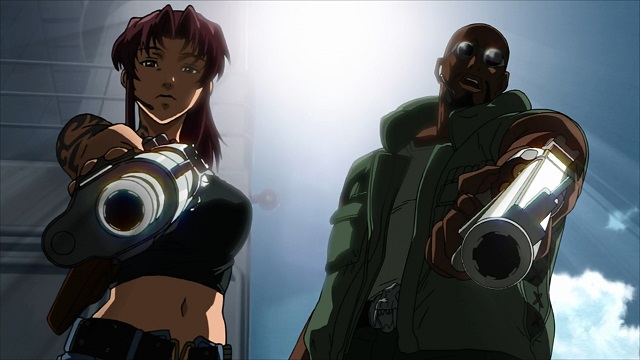
So how the hell did it come to this?
more...

Say hello to Skippy. That's probably not his name, but as we've yet to be told what it is, Skippy will do for now. Skippy is pretty much your average to slightly-below-average salaryman cliche. He works long hours for a huge multinational corporation in an unrewarding job, has no time for a life outside of work, and tends to wear a lot of gray.

His direct superior treats him like whale snot on the bottom of your shoe, and why not? That's how his boss treated him when he was just starting out in the company, and if it was good enough for him, it's good enough for Skippy, only doubly-so. After all, now HE'S the boss and he's got to make sure the underlings know it. Skippy meekly bends over and takes it, because that's how it's done in Stereotypical Salaryman's Life, and hopes to someday move up in the world, into a position where he might be able to make someone else as miserable as he is today.

His appears to be a crapsack world indeed. Nowhere in it is there room for things like zombies, bento fights, technomagical girls with kickarse scarves or happy gambling paradises. All is gray, and that's the way it's always been, and that's the way it'll always be.

So how the hell did it come to this?
more...
Posted by: Wonderduck at
04:30 PM
| Comments (10)
| Add Comment
Post contains 1933 words, total size 14 kb.
December 02, 2014
Electrics
When one thinks of railroading in the US, you either cast your thoughts towards steam engines or diesel. And rightfully so, those two styles cover probably 95% of the engine types in the country's history. But there is one other major style, one that often gets overlooked. That's Electric locomotives. Now, I'm not talking about the interurbans like Chicago's 'L' trains or New York's subway, but big engines that can pull real trains.
Despite the advantages of the electric, like not having to pull its own fuel around, they never really caught on here in America the way they did overseas. Probably that's because of the one huge disadvantage electrics bring to the field: infrastructure requirements. Overhead wiring (or the less-used third rail method) to carry power to the trains had to be installed over the entire length of a run. The cost of maintenance could be prohibitive, particularly in areas where heavy snow occurred.
That doesn't mean it wasn't used here, though.
Milwaukee Road "Little Joe".
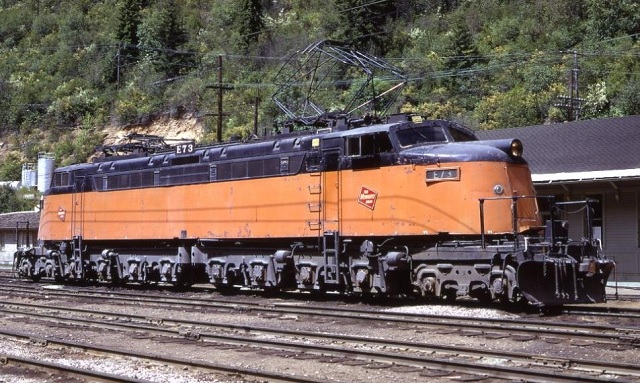
A helluva story behind these. General Electric originally built 20 of these beasts for an order from the Soviet Union... just as US/Soviet relationships went to hell and they were banned from exporting them. Eventually 12 of the locos made their way to the Milwaukee Road, where they were known as "Little Joe (Stalin)'s locomotives", which eventually got shortened to "Little Joe." With a 2-D + D-2 wheel arrangement (meaning two unpowered axles and four powered + four powered and two unpowered), the Little Joes weighed in at roughly half-a-million pounds and generated about 5100hp. By comparison, the famous EMD F7 freight engine generated 1500hp. The Little Joes ran out in Montana and Idaho on the Milwaukee Road's Rocky Mountain Division until electric service was retired in 1974. One survives in running condition at the Illinois Railway Museum, and four others of the 20 survive in non-running shape.
Pennsylvania Railroad GG1
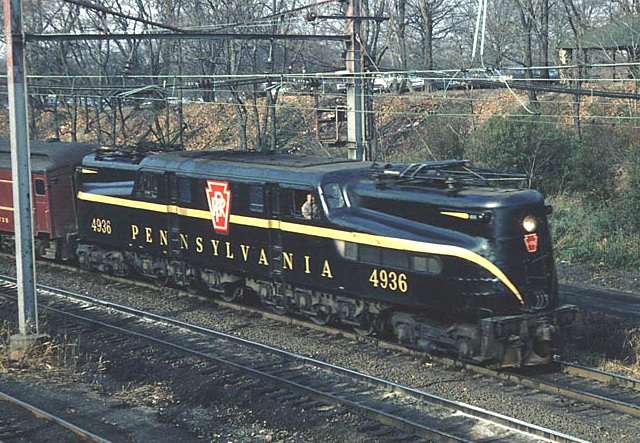
The GG1 entered service in 1935, and wasn't finally retired until 1983. In between, they were certainly the most distinctive locomotive on America's rails. Limited to use on the East Coast, they moved both passengers and freight exclusively for the Pennsy, though successor lines (Penn Central, Conrail and spinoffs, Amtrak) continued to use them as well. They weighed 475000 pounds, generated a continuous 4600hp, though that could increase to 8000hp for short lengths of time. Over 130 GG1s were built, 15 of which (and the original prototype known as "Rivets") still exist. None of them are in running condition for many reasons, not least of which was the use of PCBs in their transformers.
So there ya go, a couple of electric locomotives for your perusal.
Despite the advantages of the electric, like not having to pull its own fuel around, they never really caught on here in America the way they did overseas. Probably that's because of the one huge disadvantage electrics bring to the field: infrastructure requirements. Overhead wiring (or the less-used third rail method) to carry power to the trains had to be installed over the entire length of a run. The cost of maintenance could be prohibitive, particularly in areas where heavy snow occurred.
That doesn't mean it wasn't used here, though.
Milwaukee Road "Little Joe".

A helluva story behind these. General Electric originally built 20 of these beasts for an order from the Soviet Union... just as US/Soviet relationships went to hell and they were banned from exporting them. Eventually 12 of the locos made their way to the Milwaukee Road, where they were known as "Little Joe (Stalin)'s locomotives", which eventually got shortened to "Little Joe." With a 2-D + D-2 wheel arrangement (meaning two unpowered axles and four powered + four powered and two unpowered), the Little Joes weighed in at roughly half-a-million pounds and generated about 5100hp. By comparison, the famous EMD F7 freight engine generated 1500hp. The Little Joes ran out in Montana and Idaho on the Milwaukee Road's Rocky Mountain Division until electric service was retired in 1974. One survives in running condition at the Illinois Railway Museum, and four others of the 20 survive in non-running shape.
Pennsylvania Railroad GG1

The GG1 entered service in 1935, and wasn't finally retired until 1983. In between, they were certainly the most distinctive locomotive on America's rails. Limited to use on the East Coast, they moved both passengers and freight exclusively for the Pennsy, though successor lines (Penn Central, Conrail and spinoffs, Amtrak) continued to use them as well. They weighed 475000 pounds, generated a continuous 4600hp, though that could increase to 8000hp for short lengths of time. Over 130 GG1s were built, 15 of which (and the original prototype known as "Rivets") still exist. None of them are in running condition for many reasons, not least of which was the use of PCBs in their transformers.
So there ya go, a couple of electric locomotives for your perusal.
Posted by: Wonderduck at
11:07 AM
| Comments (9)
| Add Comment
Post contains 445 words, total size 3 kb.
38kb generated in CPU 0.1754, elapsed 0.6243 seconds.
47 queries taking 0.5621 seconds, 297 records returned.
Powered by Minx 1.1.6c-pink.
47 queries taking 0.5621 seconds, 297 records returned.
Powered by Minx 1.1.6c-pink.









